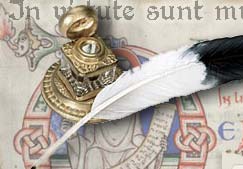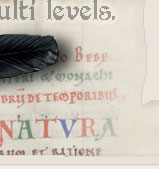From ‘Tracts in Shorthand’ 1887
JANES’S UNIVERSAL CIPHER
********************
Cipher writing is commonly regarded as being impenetrable in proportion to its arbitrary complexity, yet it is understood to be a maxim among cryptographers that any cipher can be discovered. In this matter, as in “Shorthand without complications,†I seek to attain my end by simple means. Again, the plan on which an ordinary cipher is arranged is peculiar to itself, and is kept, if possible, a close secret. I give a general or common plan, on which countless ciphers can be constructed, with greater or less intricacy according to the purposes to which they are to be put.
All these ciphers are made out of the signs 1,2,3,4,5,6,7,8,9,0. But as twenty-six letters have to be provided for, while these signs are but ten in number, it is clear that combinations of figures must be employed. When figures are thrown together, they must, therefore, in a cipher, be distinguished in some way. If an arbitrary mark be used, it at once attracts attention. Therefore, I propose to make a figure serve the purpose of dividing the figures. Any single figure may be taken, but the one selected must not then be used in representing any letter of the alphabet. The figure selected I term a “spacer,†its function being to “space off,†one representative of a letter from another. If the 0 be taken, and figures (always excluding the 0) be used up to 100, there are 90 sets of figures to choose from, the tens containing the 0 being excluded. These 90 sets will suffice to form a practically infinite number of alphabets, so that there need be no fear of an alphabet drawn up by one person being identical with one compiled by another. Taking 0 as the “spacer,†an alphabet may be formed on this model:-
A 86 G 62 M 44 S 16 Y 14
B 25 H 11 N 7 T 9 Z 92
C 43 I 55 O 6 U 19
D 97 J 18 P 63 V 8
E 74 K 5 Q 1 W 13
F 38 L 2 R 21 X 45The figures are taken at random, the only things to be careful about being (1) to omit the “spacer†figure from the alphabet, and (2) not to allot the same sign to two letters. A message may now be written, the “spacer†being placed after the sign for each letter, and doubled at the end of a word, as in –
130550202002507400130550901100140601900607001608609019
021097086014008609009011074001608604407400905504407400
860709700630208604307400.A person writing a cipher communication to a correspondent must, of course, use a key, and his correspondent must have a duplicate of the key. The receiver of this cipher, having the key given above’ will draw his pen through the “spacer†wherever he finds it, and will then, by referring to his key, find the figures to mean –
“WILL BE WITH YOU ON SATURDAY AT THE SAME TIME AND PLACE.â€Â
The cipher code here set forth is the most elementary form in which the plan can be applied, but it would probably be found safe enough for all occasions on which great precaution was not required. It may be made a little more difficult, however, by omitting the second 0 at the end of a word, and treating the whole message as continuous letters thus –
13055020202507401305509011014060190607016086090190210970
86014086090901107401608604407409055044074086070970630208
60430740 – equivalent to –
“WillbewithyouonSaturdayatthesametimeandplace.â€Â
It does not need much ingenuity to divide these letters into words.
Any one of the single letters may be used as a “spacer,†instead of 0, and then 0 can be used in the alphabet. Still keeping the alphabetical symbols within two figures, the number of distinct alphabets which could be constructed is practically, though not theoretically, as exhaustless as before. With 2 as the “spacer,†and therefore not employing 2 in the alphabet, we may draw up a plan or key on this model:-
A 5 G 48 M 3 S 8 Y 66
B 17 H 61 N 55 T 40 Z 99
C 81 I 00 O 33 U 90
D 1 J 30 P 4 V 7
E 6 K 64 Q 10 W 50
F 19 L 46 R 01 X 18Supposing that one of those singular beings, who have only to withdraw for a few days from the family circle in order to obtain anything they wish, should have practised on this alphabet and left a key behind him, we might see in an “agony†column something like the following, which would be rather more puzzling than the guileless ciphers often advertised:-
126252012012332172620124020126240290201255261233232625
255212524624628261252462462172621923320124820027262552
482332726201255233201282102902520126212.Treating this like the former illustration – drawing the pen through every 2, and referring to the key, the message is translated thus:-
“dearrobertreturnhomeandallshallbeforgivengovernorsquared;†or
DEAR ROBERT.- Return home, and all shall be forgiven. Governor squared.
If these ciphers should be employed in the service of love, I would recommend ladies to insist on offers of marriage being made in longhand. Jurymen are naturally inclined to look favourably on a fair plaintiff, but it would be a rude shock to their feelings to learn that the declaration, “Darling, I adore you. Only say you will be my wife,†was conveyed in a prosaic row of figures. This sort of thing might affect the amount of damages.
The repetition of the “spacer†would probably attract the attention of the curious, and therefore the next step in ensuring secrecy is to disguise the “spacer.†The most simple way of doing this is to employ two “spacers,†used alternately. The withdrawal of two figures (neither being 0) from those available for the alphabet somewhat reduces the supply of material, but yet leaves enough for variety, the number of combinations now possible – keeping to only two figures – being still many trillions. Taking 4 and 7 for “spacers,†an alphabet may be made thus:-
A 18 G 29 M 20 S 5 Y 6
B 2 H 22 N 30 T 60 Z 99
C 68 I 15 O 50 U 13
D 1 J 11 P 66 V 8
E 03 K 81 Q 36 W 9
F 55 L 39 R 33 X 10On this plan we will suppose a commercial telegram to be sent –
54673041715468718460703468750433730403733415730429
7541573948172413764.
“Syndicate concerning Silk. Buy.â€Â
But there is no reason, apart from cost of telegraphing – that is to say, with regard to communications by letter there is no reason at all – why the signs should be confined within two figures, and when higher numbers are taken the variety of combination is vastly increased. Indeed, two letter “spacers†and a word “spacer†might then be employed, and the liability of the “spacer†to draw too much attention to itself would be considerably diminished.
Where communications are constantly passing, several alphabets might be arranged, the order of which could be settled by the person sending the message. Supposing 9 such alphabets to be drawn up, and numbered, and the duplicates correspondingly numbered, the person sending a communication could fix the order in which they should become the keys to the message. It would be understood between the two correspondents that so many words – say ten – should be translated by means of each key in turn. Then the order of the keys could be made the first nine figures of the communication – thus: 762814953. The receiver of the message would place his keys in the order indicated, and then translate. Each key would have its own “spacer.â€Â
A government might employ 365 different alphabets or codes, each with its own word and letter “spacers,†copied in one book, and each code bearing a date, the diplomatic agents having duplicate books. A year would thus be covered. The date could be telegraphed or written without concealment, and would indicate to the recipient the key to the message. It is hardly conceivable that an artfully-arranged figure cipher such as I Have explained could be read by another Foreign Office; but supposing it to be possible, and to be done, the discovery would throw no light upon any message transmitted at another date. The entire book could be changed annually.
The last kind of cipher to be set forth is one to which I give the name of the “lockstitch,†each letter being a cipher by itself, so that the repetition of a letter in the message would not involve the repetition of a sign in the cryptogram, and the “spacer†would be changing all the time. A set of alphabets must be drawn up, each having one of the nine single figures, or 0, as its “spacer,†and the message must be taken letter by letter from each alphabet in turn. This plan need only be adopted where no labour would be too great to make assurance not merely doubly sure, but sure a hundred times over. I will suppose the following message to be sent by “lockstitch†cipher:-
“War Imminent. Rely on this. Act accordingly.â€Â
Here are 85 letters. Space does not permit of 35 alphabets being set out in full, but the reader will please to suppose that they exist, and that the necessary letters are taken from them thus (the figure after the hyphen represents the “spacer†allotted to each alphabet):-
W 486-3 I 13-4 E 3-6 H 9-1 A 21-0 I 26-1
A 0-5 N 10-6 L 628-7 I 11-4 C 02-3 N 7-4
R 91-8 E 5-0 Y 00-9 S 83-5 C 938-2 G 39-7
I 34-2 N 60-1 O 90-1 A 95-7 O 28-9 L 57-0
M 6-9 T 4-7 N 81-2 C 32-6 R 329-5 Y 631-9
M 09-2 R 07-3 T 20-8 T 50-9 D 8-6Each letter is here represented by a different sign, but that is not necessary; indeed, the complexity would, if possible, be increased by having the
same numbers to
different letters here and there. The “spacer†number follows the letter-sign, and must, therefore, be struck out as each letter is translated. The 35 alphabets would, of course, be numbered, and the numerical order, or order agreed upon, would be followed. The above message, as telegraphed or written, would look as follows:-
486305918342690921341065060147073366287009901812208911
148359573265092100239382289329586261743975706319.The “spacers†are here, to the uninitiated, utterly confounded with the letter-signs.
*****
A CHALLENGE CRYPTOGRAM.
In conclusion, I beg to submit the following cipher to cryptographers of all nations, informing them, for their guidance, that it is not a “lockstitch†cipher, though taken from more than one alphabet, and that it enshrines ordinary English words. Solutions are respectfully invited:-
113123111812132113161301081618113100300080812131008531
213058212210212012210210206015131465602171512062260262
146020107670106464062020021404062112012643402547201409
290410021204112014002010420641910961961910710264609620
1206221718690671912260260201.*****
Not being able to figure this one out and not having come across the solution anywhere, I'm hoping someone with a good head for figures will be able to give me the key.






